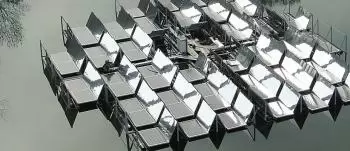
Another way to take advantage of solar energy is through floating photovoltaic installations.
A floating photovoltaic plant is a plant in which the installation of solar panels is carried out in water. These systems are equipped with the same photovoltaic panels used for common land systems, but use specific technologies to be able to float on water, including.
This variant of renewable energy also aims to generate electricity, but they offer a set of advantages compared to terrestrial photovoltaic systems.
Advantages of floating solar panels
Among the advantages associated with floating solar systems compared to non-floating systems are:
1.- Minimum land consumption
Floating plants are built on water and therefore do not consume soil by their nature, except for those parts that are used for connection to the general electrical grid. Nor do they foresee the construction of buildings and infrastructure that make it difficult to dismantle the pre-existing environmental state during the disinvestment phase.
2.- Water savings
In areas dominated by floating solar systems, evaporation of underlying water is limited by up to 80%. In the case of surfaces intended for irrigation or human consumption, it is possible to save large amounts of water depending on the percentage of coverage of the basin and the atmospheric temperature.
3.- Increased efficiency
The performance of floating photovoltaic modules is higher than systems installed on land. In terrestrial systems, the high temperatures reached in summer near the ground reduce both the performance and the useful life of solar photovoltaic modules.
The electricity produced by a floating solar plant compared to one on land can increase by 7 to 15%.
4.- Reduced maintenance
Panels installed over water do not need the frequent cleaning required on the ground, especially when compared to systems installed in dusty areas.
In the air above the free surface of water, the amount of dust is reduced compared to the air on land. Most of the dust lifted by the wind from the ground near water cannot get over the water's edge.
Additionally, there is no need to cut the vegetation that normally grows under ground-mounted solar panels. Additionally, initial site preparation is reduced to a minimum.
5.- More economical solar tracking and cooling
Compared to terrestrial systems, the presence of water makes it easier to implement solar tracking and panel cooling systems.
The increase in energy produced with these methods can reach 20% for solar tracking and 10% for cooling.
6.- Greater recyclability
In this type of installations there are practically no fixed infrastructures. Therefore, the use of non-recyclable materials for floating solar systems is less.
In particular, a higher percentage of recyclable materials are used for the construction of these plants, which are plastics (mainly HDPE), steel and aluminum.+
Disadvantages
While floating solar panels offer numerous advantages, they also present some drawbacks and challenges that must be considered when implementing these systems. Some of the key drawbacks include:
-
Initial Cost: Installing floating solar panels can be expensive compared to ground-based solar systems due to the specific materials and floating structures required.
-
Maintenance and access: Maintenance of floating solar panels can be more complicated than that of terrestrial systems. Accessing panels in water for cleaning or repairs can be difficult and expensive.
-
Impact on aquatic ecosystem: The shade created by floating solar panels can affect aquatic life in the area, decreasing the amount of sunlight reaching the water. This can have consequences on aquatic ecosystems, including the photosynthesis of aquatic plants and marine life.
-
Stability and resistance to extreme conditions: Floating photovoltaic systems must be designed to withstand adverse weather conditions, such as storms, floods and strong winds.
-
Visual impact: The installation of this type of solar panels can have a visual impact on aquatic landscapes, which could generate resistance from local communities.
-
Availability of space in water: Not all bodies of water are suitable for the installation of floating solar panels.
-
Water conditions: Water quality and the presence of algae and other aquatic organisms can influence the operation and efficiency of floating solar plants.
An example: The largest floating solar plant in the world
The world's largest floating solar plant is located in China, in the city of Huainan, Anhui province. Chinese company Sungrow Power Supply Co built the photovoltaic plant on a lake in Huainan on top of a flooded former coal mine.
The Huinan Solar Power Plant has 166,000 overwater solar panels providing 40 MW of clean energy.